Recent Articles
Popular Makes
Body Types
10 Things You Need to Know About the 2019 Nissan Leaf Plus
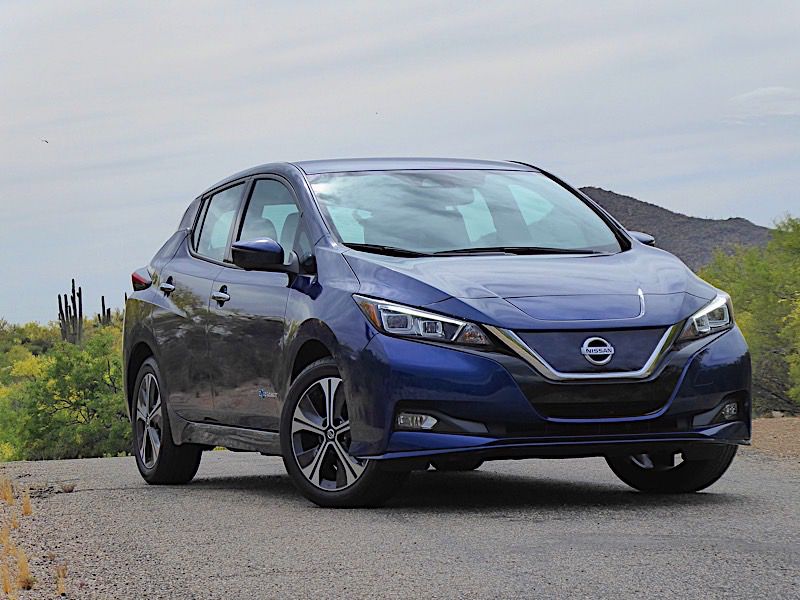
19 leaf plus front ・ Photo by Ron Sessions
Since its introduction in 2010, the Nissan Leaf has been a leader in electric car sales. More than 300,000 have been sold around the world through the end of 2018. And now with the introduction of the new Leaf Plus, Nissan joins the ranks of mainstream-priced electric vehicles with a 200-mile-or-greater driving range.
A redesign for the 2018 model year gave the Leaf a more contemporary appearance. Gone is the nerdy amphibian look of the previous-generation Leaf, replaced with modern Nissan cues such as boomerang-shaped headlamps, the V-motion grille and floating roof, among others.
The lineup now includes the standard Leaf and new Leaf Plus, both available in base S, midlevel SV and range-topping SL trim. Including the $895 destination charge, standard Leaf pricing runs from $30,885 to $37,095 and the Leaf Plus from $37,445 to $43,445. Buyers who qualify can get a $7,500 federal tax credit with a Leaf purchase.
1. The Leaf Plus has a bigger 62 kWh battery.
The main feature that differentiates a regular Nissan LEAF from a Leaf Plus is the larger Plus battery. Compared to the 40 kWh lithium-ion battery in the regular Leaf, the Leaf Plus gets a 62 kWh battery, with some 50 percent greater energy storage. That’s Chevy Bolt, Hyundai Kona EV, and Tesla Model 3 territory, to name a few.
The battery is just a few inches thick and runs under the floor and cargo area of the Leaf. Because it is mounted so low in the body, its considerable mass (about 1,000 lbs) isn’t a detriment and enhances the stability of the front-drive hatchback while helping achieve reduced yaw moments of inertia for flatter cornering. The only downside is the big battery takes up space under the cargo floor where the spare tire would typically reside, so there is no spare. The Leaf comes standard with an air compressor and tire repair kit.
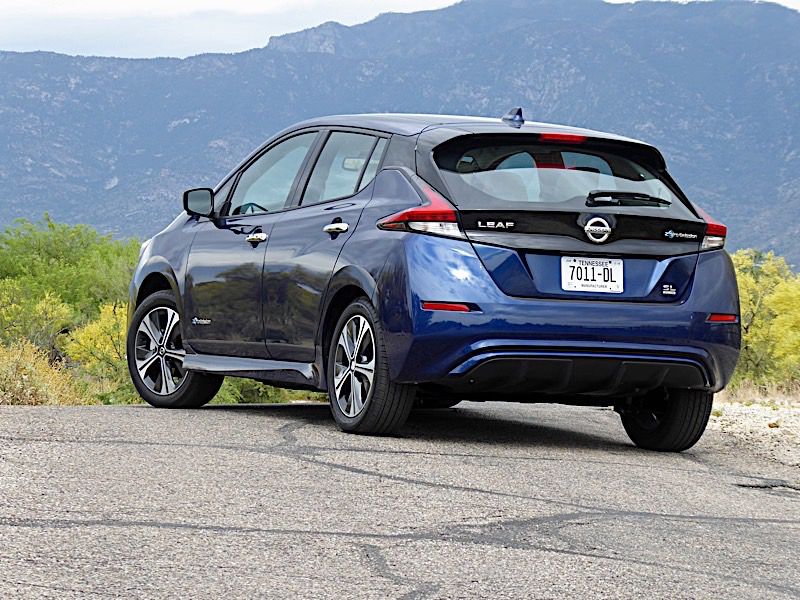
Photo by Ron Sessions
2. The Leaf Plus has a more powerful drive motor.
In addition to its larger-capacity battery, the Leaf Plus also receives a more-powerful AC synchronous electric drive motor rated at 214 horsepower and 250 lb-ft of torque. Output-wise, that’s right up there with the Chevy Bolt (200 hp and 266 lb-ft), the Hyundai Kona EV/Kia Niro EV siblings (201 hp and 290 lb-ft) and the base Tesla Model 3 (if you can find one). The Leaf Plus won’t outdrag a Mustang GT, but with the ability to accelerate from zero to 60 mph in about 6.5 seconds, it’s no ecoweenie laggard either. That’s about a full second quicker to the 60 mph mark than the standard 147-hp/236 lb-ft Leaf.
The beauty of an electric car is the smooth, turbine-like drive-off feel and instant acceleration as an electric motor’s maximum-rated torque is available from rest the moment you press the accelerator. There is no engine to rev to get to the fat part of the power curve or turbochargers to spool up.
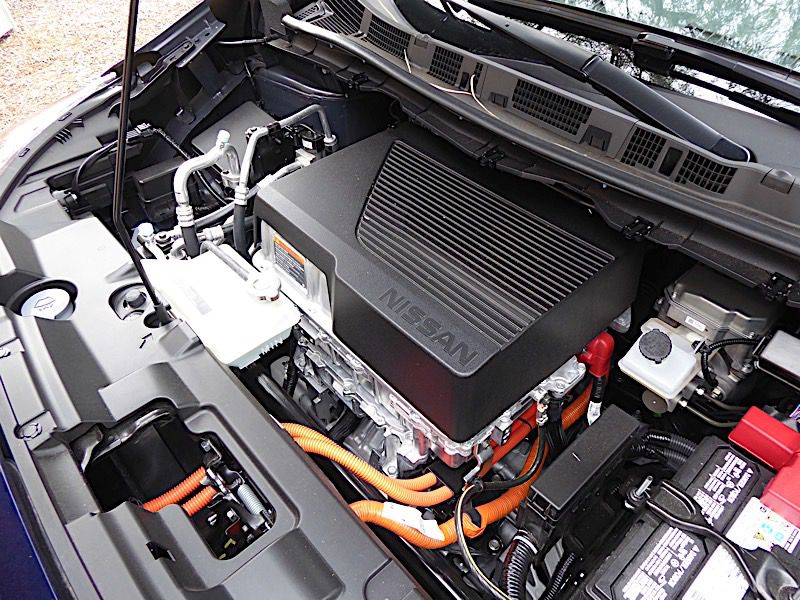
Photo by Ron Sessions
3. Both regular- and quick-charge ports are standard on the Nissan Leaf Plus.
The Leaf comes with two charge ports. The one on the right is for 120- and 240-volt outlets and works with the charging cable and inline control box that comes with the car. This cable is thick and heavy and stored in a sturdy laptop-case-like bag in the trunk. It’s a substantial piece of equipment to wrestle with. Plug the cable into the electrical source first, then once the control box’s green ready light illuminates, snap the other end into the car’s charge port.
If you are plugging into 120-volt house current, you must use the supplied Nissan 120-volt adapter, not something from the hardware store. Then be prepared to trickle-charge the Leaf Plus’s big 62kWh battery at about 12 amps for the better part of two days to get a full charge if you’ve run the battery down to a low percentage. A better plan is to get a 240-volt line installed in the garage; topping off a mostly depleted Leaf Plus battery at 30 amps with one of those takes about 11.5 hours.

Photo by Ron Sessions
4. Quick-charge capability gets you going fast.
While recharging the Leaf Plus at home overnight with a 240-volt outlet is convenient and economical, sometimes you need to charge the car on the go. Having access to a high-voltage fast-charging station such as EVgo in your area can be a great time-saver and a trip-saver if you run low on juice on the road. That’s where the Leaf’s fast-charge port on the left comes in. You can download the app on your phone, search for charge stations and open an account to pay for the energy used. The stations can juice at up to 100 amps and bring the Leaf Plus battery to an 80 percent charge in about 45 minutes—just enough time to order and down your favorite Starbucks caramel latte. Don’t try to plug into a Tesla Supercharger outlet however; the plug won’t fit the Nissan’s port.

Photo by Ron Sessions
5. It has a luxurious cabin with up-to-date tech.
Nissan didn’t skimp on accoutrements. The Leaf Plus S and SV come standard with faux-suede seat coverings with leather trim on the uplevel SL model shown here. Pushbutton start, automatic climate control, power windows with driver-side one-touch up/down and auto-locking power door locks are standard as well. The cabin is airy with large windows and good outward visibility.
On the infotainment front, all Leaf Plus models come with a 6-speaker AM/FM stereo with Bluetooth streaming, an 8-inch color touchscreen, SiriusXM satellite radio and most importantly, NissanConnect with Apple CarPlay and Android Auto. SV and SL trims add NissanConnect telematics allowing remote access to the Leaf for checking charging status, pre-heating or pre-cooling the interior and starting a charging session.
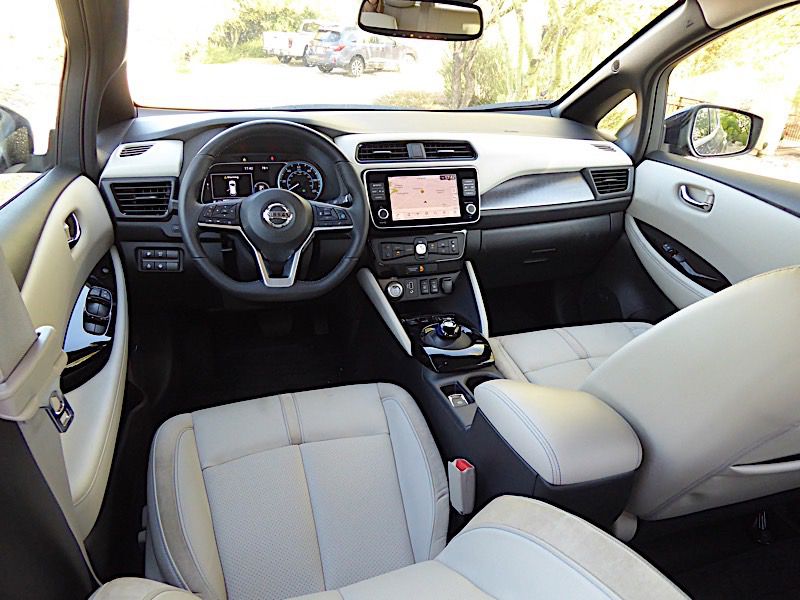
Photo by Ron Sessions
6. The Nissan Leaf Plus has an e-shifter.
The electronic gear shifter on the center console in the Leaf operates differently than what most drivers may be familiar with. The driver swivels it to the left and either pulls it rearward to engage Drive or pushes it forward to put the car in Reverse. The “B” position to the right of Drive increases the amount of regenerative braking when the Leaf is decelerating—but only slightly. There is a handy shifter pictogram on the console that explains this somewhat non-intuitive operation for newbies, but you’ll get the hang of it with practice. Putting the Leaf in Park is easy—just press the big “P” button atop the shifter.
Next to the shifter is the Eco button. Pushing this puts the Leaf in Eco mode which also increases regenerative braking but also reduces air conditioner output and electric drive motor power to conserve battery range.
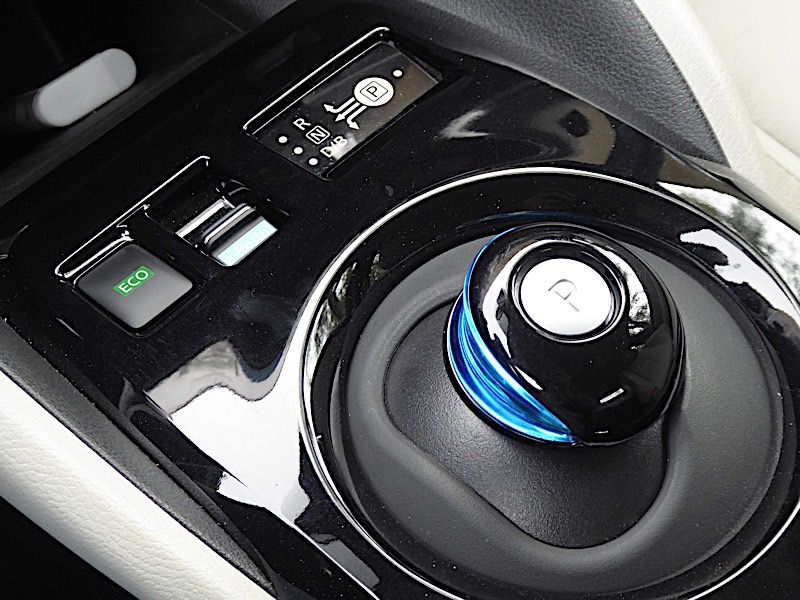
Photo by Ron Sessions
7. You can drive with just one pedal.
You can engage the e-pedal feature by toggling the switch shown above. This feature allows you to drive using just one pedal—the accelerator. Engaging the e-pedal greatly increases the amount of regenerative braking available to slow down the car when you ease up or lift your foot from the accelerator pedal. It also means that in most cases, it’s unnecessary to depress the footbrake. The car just slows down as if your foot was on the brake and you can control the amount of e-braking force up to 0.2g by how much you ease up on the accelerator.
The e-pedal even applies the rear brake lights to signal the drivers behind you that you are slowing down. It takes some practice to become proficient using the e-brake as you may find yourself stopped before you get to the stoplight or intersection. It’ll even stop and hold the car on a hill. The good news is this style of driving puts a lot of juice back into the lithium-ion battery and can help extend your driving range. Of course, applying the regular footbrake is necessary for instances such as emergency stopping and extra-hard braking, say, if a traffic light turns red unexpectedly or if another car cuts in front of you.
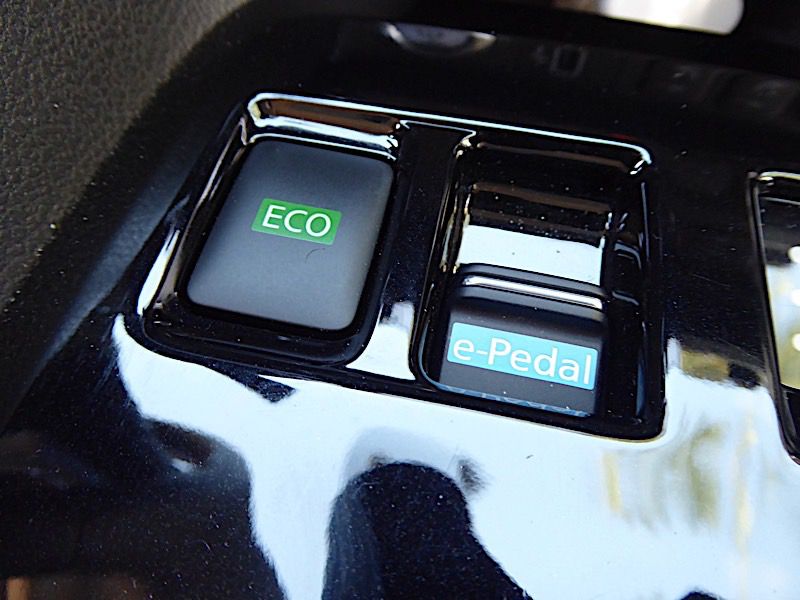
Photo by Ron Sessions
8. Nissan's ProPilot Assist is available on the Leaf Plus.
The SV and SL grades of the Leaf Plus are available with Nissan’s ProPilot Assist system. Basically, it’s an adaptive cruise control system that maintains a driver-selectable minimum following distance from the vehicle ahead with some steering assist to help keep the Leaf lane centered. This is a hands-on system that works best on major highways with well-defined and visible lane markings only. Once the driver activates the ProPilot system on the steering wheel and the system detects lane markings, a single chime sounds; a double chime is emitted when the system cannot detect lane markings and ceases to provide lane centering.
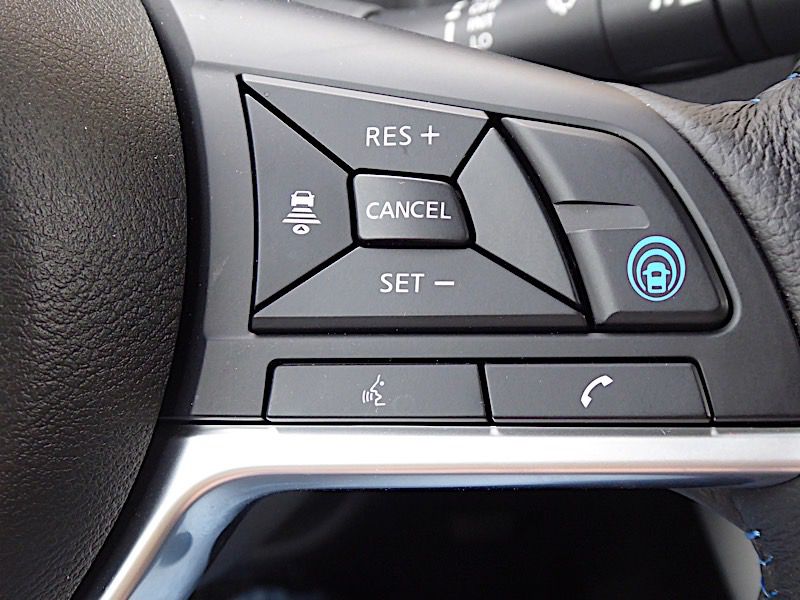
Photo by Ron Sessions
9. Safety tech includes a rear seat reminder.
All Leaf Plus models feature automatic emergency braking. The SV and SL models are available with blind-spot and rear-cross-traffic alert systems, intelligent lane intervention and on the SL only, a program that measures driver alertness. One new feature on all Leaf Plus models is a rear seat reminder. If the rear doors are opened for any reason when the car is stopped, a chime will sound and a dash message will display the next time the car is turned off to check the back seat for something or someone the driver may have forgotten about. This can be a real lifesaver in the case of children or pets left for hours in a car in extreme temperatures.

Photo by Ron Sessions
10. The Leaf Plus has a customizable backup camera view.
You can change the Intelligent Around View Monitor backup camera angle from narrow to wide or to display down one side of the Leaf to check for curbs or other obstacles out of view to the driver alongside the wheels. A 360-degree overhead view of the car and its immediate surroundings is also selectable.
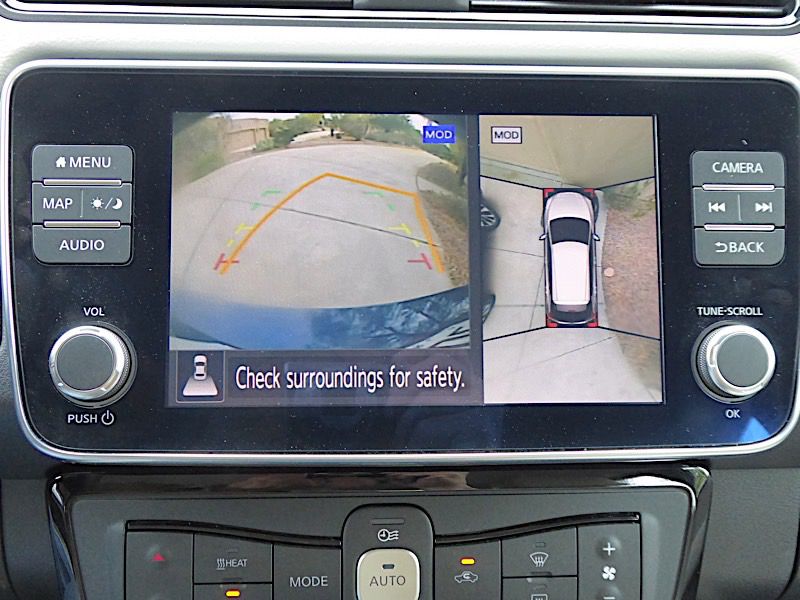
Photo by Ron Sessions